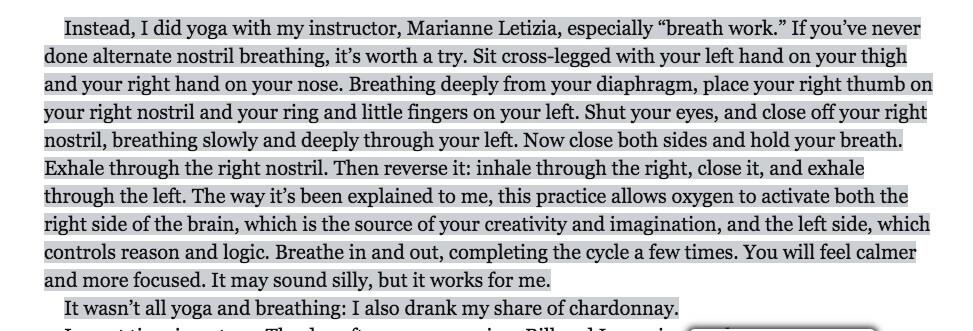Hillary Clinton’s Breathing Exercise Against Anxiety
In her new book What Happened, Hillary Clinton shares that after this year’s presidential elections, her friends advised her to take antidepressants or to see a therapist. She did not do this. Instead, she turned to an alternate nostril breathing technique suggested by her yoga teacher. It helped Hillary and now, she recommends it to everyone.
When I watched on CNN Hillary demonstrating this breathing technique, I experienced mixed feelings.
I was pleased that a traditional yoga technique to reduce air consumption attracted the attention of a renowned politician. I was glad that this Breathing Normalization practice was helping her. And I felt thankful to Hillary for spreading out a message that a breathing technique can be a substitute for antidepressants and a natural solution for despair.

Other things made me feel uncomfortable. I did not like that Hillary fell into a common trap of NOT taking breathing seriously and casually giving recommendations to everyone on how to breathe. What works for Hillary is not necessarily going to work for you and me. When it comes to breathing, something helpful to one person could be harmful to another; the instructions on how to breathe should be individual. According to Dr. Buteyko, nothing affects our health as strongly as breathing does – in positive and negative ways. He compared the power of breathing with nuclear energy; he discovered that healthy breathing patterns could miraculously restore one’s health; however, over-breathing could destroy someone’s health even faster.
The traditional yogic technique of alternate nostril breathing is an excellent Breathing Normalization tool when practiced correctly and is appropriate for someone’s breathing and health conditions. This breathing technique has the capability of reducing air consumption twice (since a person is breathing through one nostril instead of two) or even more (if a person is a mouth breather). As a result, this technique increases the level of CO2 in the lungs, boosts overall oxygenation and reduces the level of excitability of nerve cells. The outcome is less anxiety, less depression, more energy and a more stable mental state. That’s why it worked for Hillary.
Make Your Breathing More Effective
To make this technique effective, it is important to make sure that you don’t push through one nostril as much air as it would go through two nostrils or even more. You need to make an effort to reduce your air consumption by making your breathing quiet and gentle. Notice, when Hillary demonstrated this technique in her interview with Anderson Cooper, her breathing through one nostril was audible, even noisy. I hope it happened because she was slightly nervous doing this. I hope that it is not how she does it at home. If you plan on practicing this breathing technique, use Hillary’s demonstration to see how NOT to do it.
Nonetheless, Hillary’s suggestion on slowing down exhalation was excellent. This can work for anyone! A stretched exhalation if done gently, always increases the CO2 level and creates health benefits.
Referring to the instructions she received from her yoga teacher, Hillary also recommended stopping breathing after inhalation. When this advice could be helpful to people who don’t experience breathing difficulties, for those who have asthma, COPD, other types of breathing problems or heart issues, it could be dangerous. In general, Dr. Buteyko always recommended stopping breathing after exhalation, not inhalation.
Deep diaphragmatic breathing was also mentioned – a suggestion, which is more often than not, triggers hyperventilation. Of course, the diaphragm should be fully engaged in the process of breathing; however, to avoid excessive air consumption, breathing of a person in a still position (for example, a person sitting on a yoga mat) should remain being invisible – shoulders, chest and ideally even the abdominal area should not be moving driven by the waves of breathing (watch the video below to see a right example).
There was something else in this presentation, which I did not like – the tonality of it. Notice how Anderson and Hillary talked about breathing – almost as if this topic was anecdotal. Hillary said in her book, Breathe in and out, completing the cycle a few times. You will feel calmer and more focused. It may sound silly, but it works for me.
I don’t consider a conversation about breathing and its health benefits being silly. In fact, I wish that more scientists, doctors, journalists and politicians would take it seriously. It would boost national health and reduce the amounts of medication people depend on. Despite a fair amount of criticism I expressed in this article, I am grateful to Hillary for being a pioneer and making the first steps to making this a reality.

